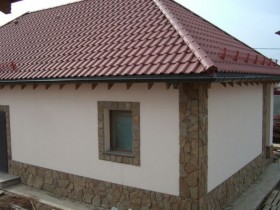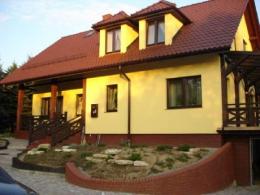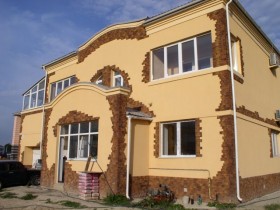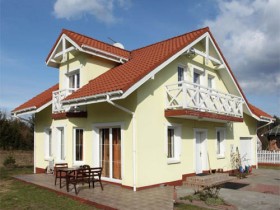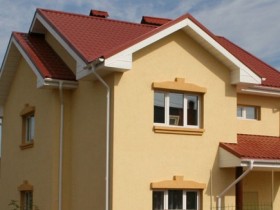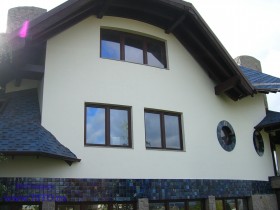- Преимущество отделки зданий декоративной штукатуркой
- Состав декоративной штукатурки
- Классификация видов декоративной штукатурки
- По связывающему элементу
- По типу наполнителя
- Пошаговая инструкция по декоративной штукатурке стен своими руками
- Советы по декоративной штукатурке своими руками
- Декоративная штукатурка : фото примеры дизайна зданий
- Статья
- Видео
Преимущество отделки зданий декоративной штукатуркой
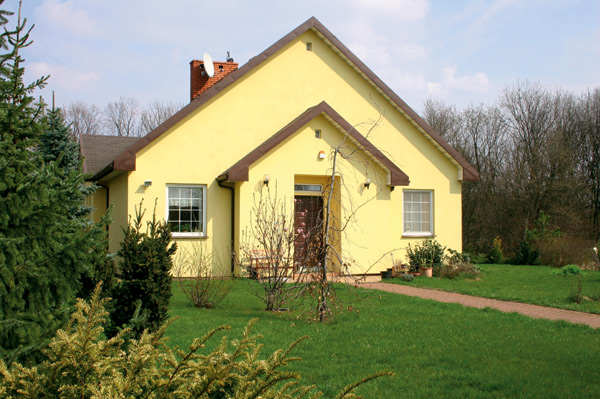
Декоративная штукатурка своими руками
Декоративная штукатурка это подходящий материал для дополнения ландшафтного дизайна любого садового стиля. Сегодня данный материал широко используется дизайнерами различных стран и континентов. Для человека, желающего уникально украсить фасад своего дома, декоративная штукатурка станет одним из наиболее подходящих вариантов, т.к. имеет следующие преимущества:
- Декоративная штукатурка имеет очень широкую разновидность материала, который способен создать как шероховатую поверхность, так и идеально гладкую.
- На сегодняшний день существует более 500 оттенков штукатурок различных видов, благодаря чему можно подобрать наиболее подходящий окрас своей постройки, которая идеально сможет украсить существующую композицию садового декора.
- Технология нанесения декоративной штукатурки различна. Некоторые виды штукатурки стен сможет осуществить даже строитель-новичок, а некоторые под силу только мастеру-дизайнеру.
- Декоративная штукатурка имеет широкий диапазон цен, благодаря чему, ее может использовать любой желающий, даже с низким месячным доходом.
- Декоративная штукатурка является долговечным отделочным материалом, который способен не только украшать фасад постройки, но и защищать его от действий грибка, влаги и других неблагоприятных действий природы.
- Декоративная штукатурка является морозостойкой, позволяет «дышать» постройке и способна выдерживать механические повреждения, поэтому ею не опасно отделывать наружную часть зданий.
- Уход за декоративной штукатуркой минимальный: максимум – это промыть грязную стену водой из шланга, а некоторые виды штукатурок вообще самоочищаются при малейшем порыве ветра.
- Декоративную штукатурку можно наносить на абсолютно любую поверхность: кирпич, бетон, гипсокартон, пеноблок, газоблок и т.д.
- С помощью декоративной штукатурки умелый дизайнер может создать на поверхности стены имитацию таких материалов для ландшафтного дизайна, как природного камня, бумаги, стеклянной поверхности и даже кожи.
- Время на отделку здания декоративной штукатуркой может составлять даже 1 день, если работать быстро, а объем работ не составляет многоэтажное здание.
- Помимо того, что декоративная штукатурка придает зданию привлекательный внешний вид и защищает от природных катаклизмов, она еще и выравнивает стены и убирает различные дефекты, а это тоже весомый плюс.
- Окрас декоративной штукатурки можно запросто поменять, просто нанеся новый слой краски поверх существующей.
Как вы видите, преимуществ у декоративной штукатурки зданий очень много, это с учетом того, что предоставлена лишь наиболее весомая часть достоинств, поэтому все же есть смысл осуществлять дизайн постройки с помощью данного материала.
Состав декоративной штукатурки
В зависимости от вида декоративной штукатурки (об этом мы поговорим чуть ниже), существует различная комбинация составляющих элементов данного материала. Но все же, какой бы вид штукатурки ни был, главными составляющими являются:
- Связывающий элемент (силиконовая смола, виниловый полимер, гипс и т.д.)
- Наполнитель (в основном это мраморная, гранитная либо кварцевая крошка)
- Различные добавки, повышающие работу с материалом и его защитные функции (антисептик, загуститель, пигмент, растворитель, водоотталкивающие вещества и т.д.)
Классификация видов декоративной штукатурки
На сегодняшний день существует множество классификаций декоративной штукатурки, а именно: для наружных и внутренних работ, в зависимости от связывающего элемента либо наполнителя, по способу нанесения на поверхность и т.д. Сейчас мы кратко рассмотрим наиболее популярные классификации декоративной штукатурки.
По связывающему элементу
В зависимости от того, как связывающий элемент состоит в основе декоративной штукатурки, принято разделять ее на такие виды:
Минеральная. Данный вид штукатурки представляет собой порошковый материал, состоящий из цемента либо извести. Преимущество минеральной штукатурки состоит в том, что она экологически безопасная, имеет низкую цену и обладает высокой прочностью. К недостаткам можно отнести слабую эластичность материала, из-за чего во время усадки здания могут образовываться трещины, а так же тот факт, что на поверхности здания, отделанного минеральной штукатуркой, постоянно будет собираться пыль. Цветовой ассортимент минеральной декоративной штукатурки состоит из нескольких оттенков белого и серого, которые можно дополнить при помощи добавления различного цветового пигмента в раствор, либо после того как штукатурка застынет просто покрасить любой краской, которую пожелаете.
Акриловая. Данная штукатурка состоит из акриловых смол, благодаря чему и получила такое название. Преимущество акриловой штукатурки заключается в ее эластичности, широком цветовом ассортименте и легкости нанесения. Недостаток акриловой штукатурки в том, что здание, после нанесения данной штукатурки, не способно «дышать» (выпускать влагу).
Виниловая штукатурка. Состоит из высокопрочных эфиров, которые делают материал пластичным, прочным и влагонепроницаемым. Благодаря данным преимуществам, на поверхности здания можно сделать узор любой формы, а следить за чистотой здания можно просто вымыв его водой из шланга.
Силиконовая штукатурка. Этот вид декоративной штукатурки является наиболее долговечным, прочным и подходящим для дизайнеров. Благодаря тому, что силиконовая смола обладает влагонепроницаемостью, и способна пропускать пар, здание будет надежно защищенно от атмосферных осадков и без проблем сможет выпускать влагу изнутри. Дизайнерам нравится силиконовая штукатурка из-за того, что на ней можно осуществлять художественную роспись, которая отлично подчеркнет ландшафтный дизайн любого садового участка. Единственный недостаток силиконовой штукатурки – высокая стоимость материала.
Силикатная штукатурка. Так же как и силиконовая штукатурка, обладает высокой влагонепроницаемостью и позволяет зданию выпускать влагу, благодаря чему предотвращается появление грибка и плесени. Преимущество силикатной штукатурки в том, что она не допускает оседание пыли на поверхность здания, недостаток – довольно узкий цветовой ассортимент и быстрое время схватывания (поэтому ее необходимо наносить как можно быстрее).
Гипсовая штукатурка. Названа так из за того, что в основе лежит гипс. Преимущество гипсовой штукатурки в ее пластичности и пористости. Благодаря пластичности гипса, можно без труда создавать различные элементы декора на фасаде здания, а пористость способствует хорошему выпусканию пара изнутри постройки.
По типу наполнителя
Исходя из того, какой наполнитель лежит в основе штукатурки, существует следующая классификация данного отделочного материала: фактурная, структурная и венецианская штукатурка.
Фактурная штукатурка состоит из каменной крошки, размером от 4 до 6 мм. В качестве наполнителя могут выступать мелкие камушки, минеральная крошка, слюда и даже древесная кора. Рекомендуется наносить фактурную штукатурку, используя пневматический пистолет.
Структурная штукатурка состоит из тех же элементов, что и фактурная штукатурка, только вот размер частиц на порядок меньше, благодаря чему поверхность фасада становится менее рельефной и более гладкой. Очень часто структурную штукатурку называют короедом, т.к. с виду она напоминает кору дерева.
Венецианская штукатурка состоит из мраморной муки и является наиболее дорогостоящим из вышеперечисленных отделочных материалов. Данный вид декоративной штукатурки создает очень роскошный и привлекательный вид постройки, но в то же время требует работы мастера.
Пошаговая инструкция по декоративной штукатурке стен своими руками
Как уже говорилось ранее, декоративная штука своими руками не представляет особой сложности, необходимо лишь знать азы этого дела, которые мы сейчас вам предоставим.
Первым делом необходимо подготовить стены для декоративной штукатурки. Начинать необходимо с того, что сбиваем все выступы раствора, слои краски и старые обои (если штукатурка осуществляется внутри здания). Далее стена тщательно очищается от пыли и грязи, после чего переходят к ее грунтовке, шпаклевки (если это требуется), зачистке и финальной шпаклевки. После того как стена будет выровнена и полностью высохнет, переходят к нанесению первого слоя штукатурки. Если вы используете гипсовую штукатурку либо минеральную, тогда предварительная шпаклевка не требуется.
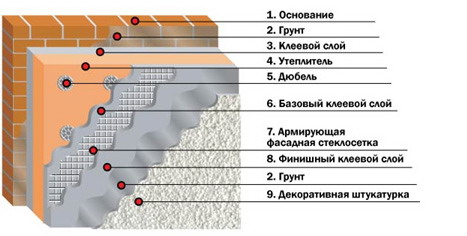
«пирог» для штукатурки
Для того, что бы осуществить штукатурку стен, необходимо иметь следующий набор инструментов:
- Емкость для раствора
- Емкость с водой
- Мастерок
- Гладилка
- Шпатели различного размера
- Терка (деревянная либо металлическая)
- Скотч (если потребуется разделять участки стен для различного вида декора)
Теперь, наконец-то, переходим к декоративной штукатурке стен. Для этого необходимо сделать раствор подходящей вязкости и с помощью шпателя нанести его на стену тонким слоем (2-3 мм). Исходя из того, какой вид штукатурки будет выбран, технология так же может видоизменятся: для одного типа материала необходимо наносить штукатурку в 5-10 слоев, для другого достаточно одного.
Так же технология будет зависеть от дизайна стены – то ли она будет шероховатой, то ли гладкой. Что вывести идеально гладкую стену, необходимо нанести слой штукатурки, подождать пока он слегка схватится и широким шпателем (либо смоченной гладилкой) разровнять его по стене.
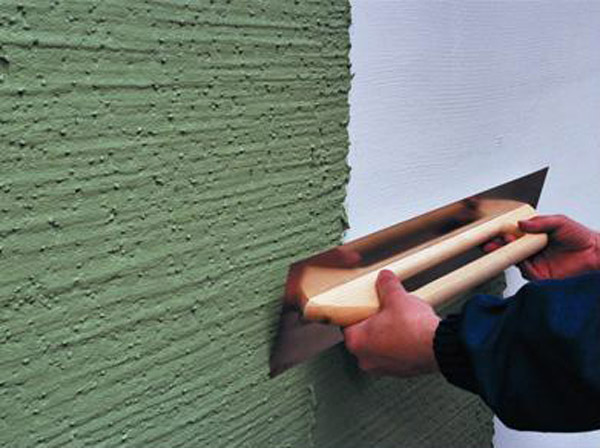
Создаем шероховатость гладилкой
Для создания шероховатой стены можно использовать различные приспособления: терку, рельефный валик, кисть, щетку, мочалку и даже палец либо ладонь.
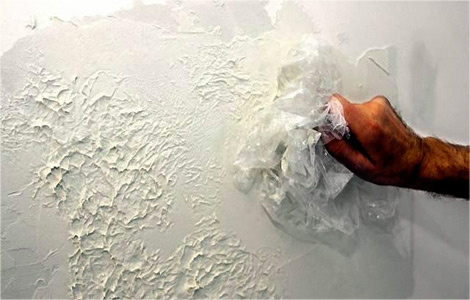
Создание шероховатой стены
Существует такой способ создания рельефной поверхности, как нанесение на оштукатуренную стену раствора соляной кислоты (10%), которым промывают стену на протяжении 3-4 дней.
После того, как стена будет полностью оштукатурена необходимо дать ей время высохнуть (обычно это составляет 1 сутки) и приступать к ее окрашиванию, если это потребуется.
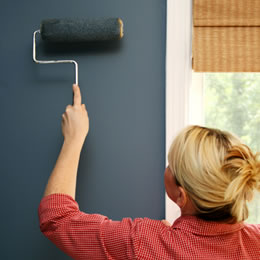
Красим штукатуренную стену
Окраску стен так же можно осуществить валиком, но рекомендуется использовать пулевизатор. В зависимости от цвета штукатурки, окрас происходить в несколько слоев.
Специалисты рекомендуют окашивать штукатурку при помощи пигментов во время замешивания раствора. Для этого просто мешая раствор, понемногу добавляется пигмент до тех пор, пока не получится подходящий оттенок. Так же данную операцию можно произвести в магазине, в котором вы приобретаете штукатурку.
Советы по декоративной штукатурке своими руками
Для того, что бы оштукатуренное здание прослужило как можно дольше, не испортив свой внешний вид необходимо придерживаться простых советов, которые дают специалисты:
- Старайтесь произвести штукатурку стен за один подход, т.к. застывшая штукатурка будет в дальнейшем отличаться оттенком от нанесенной позже.
- Выполнять декоративную штукатурку своими руками необходимо осенью либо весной, когда создается идеальная для этого дела температура: 5-25 градусов выше нуля.
- Не жалейте денег на декоративной штукатурке, лучше один раз заплатить за более качественную и наслаждаться ее видом и долговечностью, нежели переделывать все и платить в 2 раза больше из-за того, что штукатурка более дешевая и не прослужила даже один сезон.
- Перед тем как штукатурить стену, тщательно очистите ее от грязи и оставшейся прошлой штукатурки и краски.
Декоративная штукатурка : фото примеры дизайна зданий
Для того, что бы вдохновить вас на декоративную штукатурку садовых построек своими руками, предоставим несколько показательных фото примеров:
- Декоративная штукатурка
Рекомендуем так же ознакомиться со статьей озеленение кровли садовых построек!

